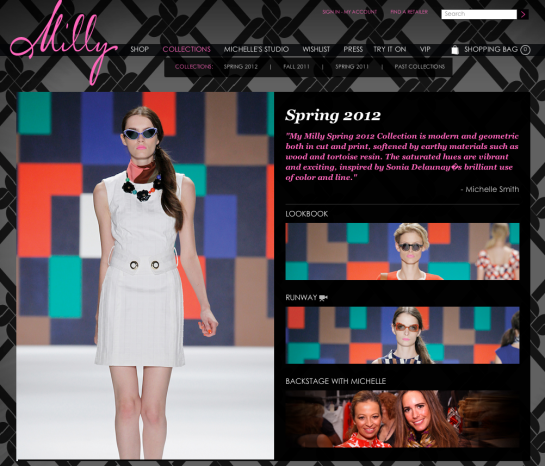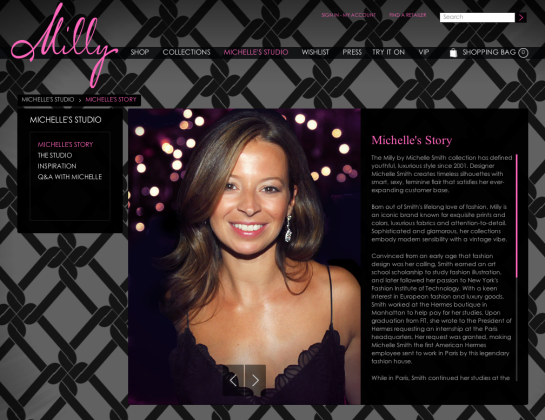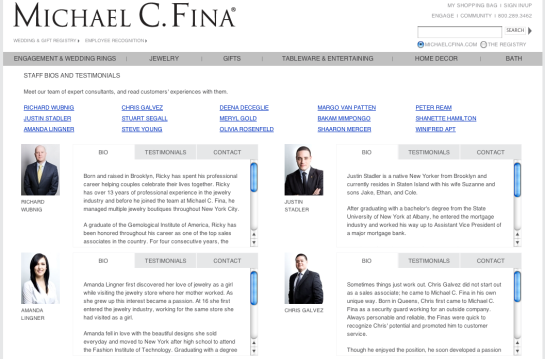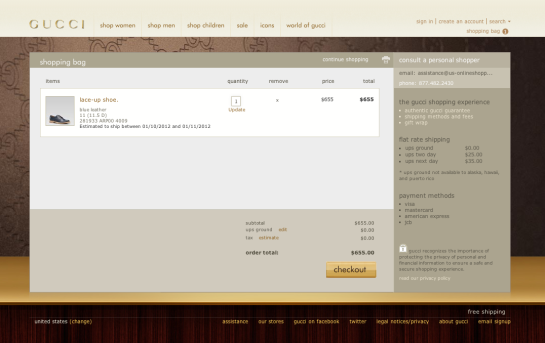As we examined in a previous post, the luxury industry is continuously evolving as the online space becomes a more prominent stage for retailers to sell and market their products. Here we’d like to look at how a few of our luxury clients have portrayed their brands in the online space.
Milly
Homepage: The gateway to the Milly ecommerce site immediately draws users in with flashy (literally) design elements and inviting calls to action.
- The homepage design incorporates bright light bulb flashes and animation of the logo upon first arriving at the site.
- For variety, the background graphics and model images swap out after a browser refresh.
- Shopable model images are displayed and lead upon click to the corresponding look on the brand’s runway video hosted in a separate section of the site.
- Special messaging is displayed in the “What’s Happening” section toward the middle of the page.
- Social media icons are highlighted in the header.
The Milly ecommerce site pairs beautiful design with the brand’s signature prints to showcase the equally beautiful apparel and accessories.
Going beyond simply an online shop, Milly also features a Collections section where users can view a shopable lookbook and runway video as well as backstage photos with the designer Michelle Smith.
The brand’s prestige is emphasized in the press section, where a media gallery displays editorial hits, celebrity fans, and event images.
The “Michelle’s Studio” section of the site gives customers access to the designer’s background, images of the studio, inspirational storyboards, and a Q&A series.
For additionally perks and a sense of exclusiveness, regular customers of MillyNY.com can opt to join the VIP program.
Diptyque
Homepage: With high-quality product images, diptyque showcases featured collections that rotate in the main content area of the homepage.
The “Explore 34” section is an impressive design piece created to promote the brand’s new line of products named after the birthplace of the first diptyque boutique—34 boulevard saint germain in Paris. Parallax technology enables users to scroll through the story of the signature line, where creative graphics are changed with each slide.
Each product detail page includes beautiful images with a zoom feature, and customers can connect with the brand by “sharing a diptyque experience.”
The diptyque brand has a charming history that is told through the site’s editorial “Our Story” section.
Michael C. Fina
Homepage: With a simple yet classic color scheme and top-of-the-line imagery, Michael C. Fina strives to create an equally elegant entrance for the online store as its Fifth Avenue location.
- The main content area features rotating shopable product images.
- Three image blocks toward the bottom of the page display designer spotlights and an entry to the company’s acclaimed wedding and gift registry.
Multiple views of each product are displayed on the product details page, and the zoom feature does not compromise the quality of the images.
A comprehensive Jewelry Education section emphasizes the expert status Michael C. Fina has in this industry. Customers can explore information on diamonds, metals, precious gems, and much more.
With the largest selection of engagement rings and wedding bands on the East Coast, a digital version of the beautifully designed Michael C. Fina Diamond Book allows customers to read through the process of choosing a ring with the Fina family.
Online users can connect with the in-store consultants by viewing the Staff Bios and Testimonials page.
We believe all three of these brands successfully represent their brands online and can’t wait to see what they do next.




















